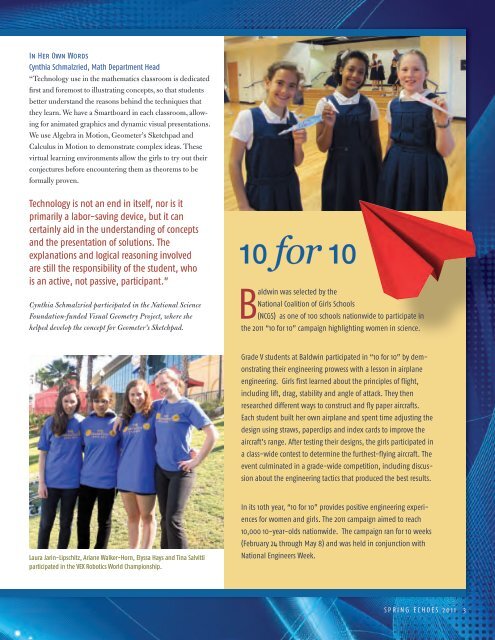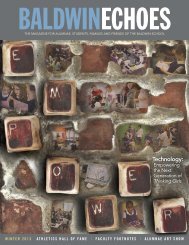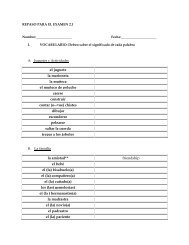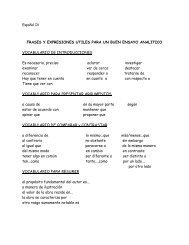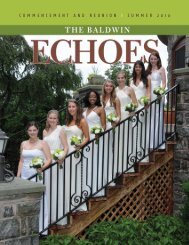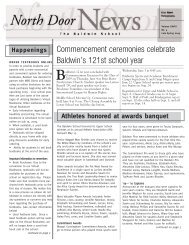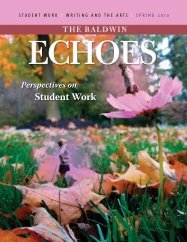Spring 2011 - Baldwin School
Spring 2011 - Baldwin School
Spring 2011 - Baldwin School
- No tags were found...
Create successful ePaper yourself
Turn your PDF publications into a flip-book with our unique Google optimized e-Paper software.
in her own Words<br />
Cynthia Schmalzried, Math Department Head<br />
“Technology use in the mathematics classroom is dedicated<br />
first and foremost to illustrating concepts, so that students<br />
better understand the reasons behind the techniques that<br />
they learn. We have a Smartboard in each classroom, allowing<br />
for animated graphics and dynamic visual presentations.<br />
We use Algebra in Motion, Geometer’s Sketchpad and<br />
Calculus in Motion to demonstrate complex ideas. These<br />
virtual learning environments allow the girls to try out their<br />
conjectures before encountering them as theorems to be<br />
formally proven.<br />
Technology is not an end in itself, nor is it<br />
primarily a labor-saving device, but it can<br />
certainly aid in the understanding of concepts<br />
and the presentation of solutions. The<br />
explanations and logical reasoning involved<br />
are still the responsibility of the student, who<br />
is an active, not passive, participant.”<br />
Cynthia Schmalzried participated in the National Science<br />
Foundation-funded Visual Geometry Project, where she<br />
helped develop the concept for Geometer’s Sketchpad.<br />
Laura Jarin-Lipschitz, Ariane Walker-Horn, Elyssa Hays and Tina Salvitti<br />
participated in the VEX Robotics World Championship.<br />
10 for 10<br />
<strong>Baldwin</strong> was selected by the<br />
National Coalition of Girls <strong>School</strong>s<br />
(NCGS) as one of 100 schools nationwide to participate in<br />
the <strong>2011</strong> “10 for 10” campaign highlighting women in science.<br />
Grade V students at <strong>Baldwin</strong> participated in “10 for 10” by demonstrating<br />
their engineering prowess with a lesson in airplane<br />
engineering. Girls first learned about the principles of flight,<br />
including lift, drag, stability and angle of attack. They then<br />
researched different ways to construct and fly paper aircrafts.<br />
Each student built her own airplane and spent time adjusting the<br />
design using straws, paperclips and index cards to improve the<br />
aircraft’s range. After testing their designs, the girls participated in<br />
a class-wide contest to determine the furthest-flying aircraft. The<br />
event culminated in a grade-wide competition, including discussion<br />
about the engineering tactics that produced the best results.<br />
In its 10th year, “10 for 10” provides positive engineering experiences<br />
for women and girls. The <strong>2011</strong> campaign aimed to reach<br />
10,000 10-year-olds nationwide. The campaign ran for 10 weeks<br />
(February 24 through May 8) and was held in conjunction with<br />
National Engineers Week.<br />
SPRing echoeS <strong>2011</strong> 3


